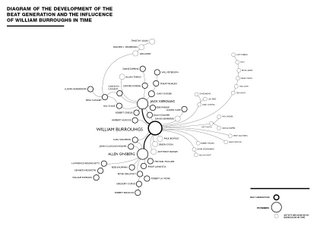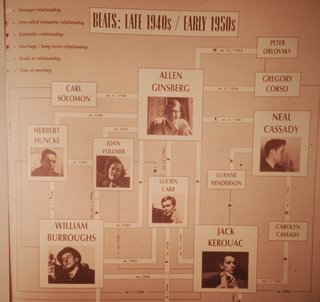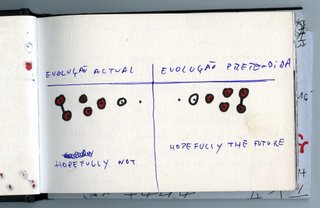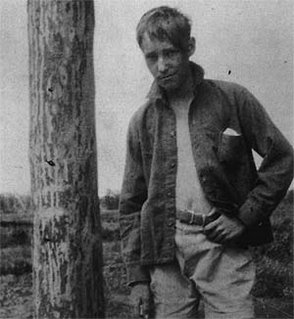William Burroughs
Friday, December 01, 2006
Tuesday, November 28, 2006
Monday, November 27, 2006
Diagram research
Research on diagrams and network options.
Rhizome Navigation - Example of rhizomic networking
Friday, November 24, 2006
Synergies - The glue of the group
I find it incredibly fascinating what kept these men together, what kind of “glue” helped them to not only stay alive but to be heard, understood and followed…
A word keeps popping up in my head: synergies
SYNERGY (plural syn•er•gies)
Combined effort being greater than parts.
The working together of two or more people, organizations, or things, especially when the result is greater than the sum of their individual effects or capabilities.
This gathering of efforts is mostly engaged by cultural similarities.
Thursday, November 23, 2006
Quotes
"Nobody knows whether we were catalysts or invented something, or just the froth riding on a wave of its own. We were all three, I suppose."
- Allen Ginsberg
"Once when Kerouac was high on psychedelics with Timothy Leary, he looked out the window and said, 'Walking on water wasn't built in a day.' Our goal was to save the planet and alter human consciousness. That will take a long time, if it happens at all."
- Allen Ginsberg
"The so-called Beat Generation was a whole bunch of people, of all different nationalities, who came to the conclusion that society sucked."
- Amiri Baraka
The Beat goes on!
The Beat Generation itself has had a huge influence on Western Culture.
They had a large intellectual effect in encouraging the questioning of authority and many of them were very active in popularizing interest in Zen Buddhism in the West.
The Beat writers were a small group of close friends first, and a movement later. The term "Beat Generation" gradually came to represent an entire period in time.
The core group consisted of Jack Kerouac, Allen Ginsberg and William S. Burroughs, who met in uptown Manhattan in the mid-40's.
Most of them struggled for years to get published, and it is inspiring to learn how they managed to keep each other from giving up hope when it seemed their writings would never be understood.
They were the first group of people to defy the norm. To speak out what they felt was wrong. To make them selves heard!
They were a liberation force.
As questions demand answers!
Kerouac, Ginsberg & friends in New York ( silent footage)
GO TO: http://www.netherworld.com/~mgabrys/william/media/life2.wav
A Documentary on his Life (part 1 of 10)
Documentary (part 1 of 10)
go to Youtube.com to get the other 9 parts...
Second stage of Research - William Burroughs as part of a collective
For those that have no idea what was the Beat Generation i´ll try to put it as simple as possible.
The Beat Generation was a group of American writers(mostly), who came to prominence in the late 1950s and early 1960s.
Their most important works are Jack Kerouac's "On the Road" (1957), Allen Ginsberg's "Howl" (1956), and William S. Burroughs's "Naked Lunch" (1959).
In many ways, the Beats can be taken as the first subculture. During the post-World War II era they were one of the forces engaged in a questioning of traditional values WHICH PRODUCED A BREAK with the mainstream culture that to this day people react to - or against
(It was the birth of Ethical and Social aware free thought)
GO TO : http://www.netherworld.com/~mgabrys/william/media/morons2.wav
William Burroughs -
By the beggining of the 90's and pushing toward eighty, William Burroughs was becoming increasingly frail, although it was really a miracle he had lived as long as he did.
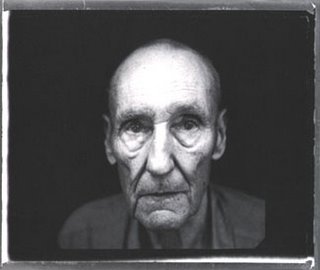
On August 1, 1997, at age 83, he had a heart attack in his Lawrence home. He died the next day.
He was the last original Beat writter to die.
William Burroughs - From New York to Kansas
As New York started do get too expensive for him, he started looking for a cheapest place to stay. In late 1981 he moved back to Kansas City area (where he originates from.)
Between 1981 and 1997, Burroughs published over 30 books.
He invented "shotgun" art in this period. It was exactly what it sounds like. He would load one of his guns with a shell packed it with ink pigments and then blast the canvas.

Burroughs at his Kansas City home, signing one
of his paintings, 1993
William Burroughs - The death of his son
Being back in America brought Burroughs back into contact with his son, William Burroughs III (known as Billy, Jr.). In general, they did not get along very well. In fact William Jr. didn't get along with anyone very well, and with the exception of their abuse of drugs and alcohol, father and son didn't have much in common. Despite attempts by both William and Allen to help him out, William, Jr. later ended up as a broken down hippie wandering around streets.
In 1981, at age 34, he was found dead in a ditch.
William Burroughs - Back in America
At the beginning of 1974, he was back in New York. He had returned to America after more than twenty years abroad.
Although Jack Kerouac had been dead for over four years, struck down by an alcohol-induced, Allen Ginsburg was nearby, having settled on a farm in upstate New York. Not only did he help William get the teaching job, but he also helped him arrange public readings. He turned out to be quite good on the lecture platform and the pay was much better than in Europe.

With Patti Smith & Ginsberg at Nova Convention,
New York 1978.
William Burroughs - The oportunity for another step on his life
William slowly got more and more dissatisfied with London even though he could take drug rehabilitation programs as often as he pleased. A major problem was that London's pub and restaurant hours didn't fit with Wiliam's lifestyle, and although he had a number of friends, he didn't see them all that often. But pure inertia kept him in England until he got a letter from Allen Ginsberg asking him to come teach a writing course at the City College of New York.
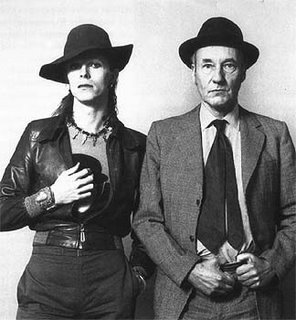
Burroughs with David Bowie for »Rolling Stone«,
London 1974.
William Burroughs - London (1954-1961)
Went back to London for another cure.
He spent more than a decade in England, from 1960 through 1973, and saw both the rise of the Beat Generation and fall of the hippie movement .
During those years Burroughs published more than twenty books, but because they were often by small presses he didn't get large royalties.
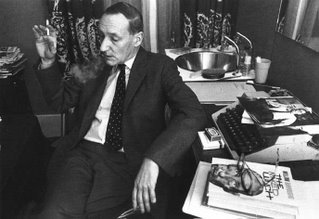
Burroughs hotel Rushmore,
London 1965.
William Burroughs - Paris (1958-1959)
Soon times changed for Burroughs.
He decided to get way from Marocco and moved to Paris. In 1959, while in Paris, "Naked Lunch" made it into print, and when an American edition was published in 1962, it received some surprisingly good reviews.
Whille in Paris, he developed a friendship with artist Brion Gysin. Their friendship lasted until Brion's death in 1986, and most importantly, it was Brion who discovered what many think Burroughs invented: the art of the cut-ups.
Living in Paris had advantages in the sense that it brought him back into daily contact with the Beat crowd and their way of life. But it also had its disadvantages, it provided him a bhoemian enviroment where drugs where taken on a daily basis(as most of the initial group were living there).
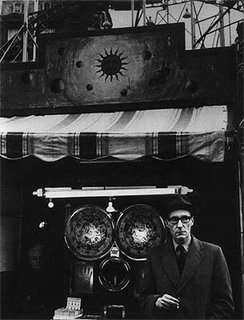
Burroughs in front of the booth of a fortune teller
on a Paris fleamarket, 1962.
William Burroughs - Back in Tanger ( The Naked Lunch comes to light)
Back in Tangiers, he was now able to focus on writing. Soon he was back on drugs, and some decadence periods came by. At this time his writing was his “way to escape reality”. Jack Kerouac, Allen Ginsberg, and Peter Orlovsky used to visit him constantly, helping him with his work. From constant drug use to intense writing the “Naked Lunch” (Burroughs most known work) was born.

Burroughs [right] with Peter Orlovsky [left] and Jack Kerouac [middle] on Tanger
Beach, 1957.
William Burroughs - First time in London (the first cure)
William soon realized he could either be a live writer or a dead junkie, but not both. There was only one thing to do.
The 41 year old William Burroughs borrowed money from his parents and flew to England and had a drug treatment program.
In London, he entered into an cure which quickly did the trick. The fact that England treated addicts as victims, rather than criminals, made a deep impression on him. For the rest of his life he thought criminalization of drug addiction was the stupidest thing any country could do.
William Burroughs - The Exile
After Vollmer's death, Burroughs drifted through South America for several months, looking for a drug called Yage, which could supposedly ease opiate addiction. He produced two novels during this time, "Junkie" exploring his morphine addiction, and "Queer" exploring his homosexuality.
He moves to Tanger for the next 5 years (from 1953 to 1958) he was living in a commercial establishment devoted to manly taking drugs almost continuously, he somehow was able to find time to write.
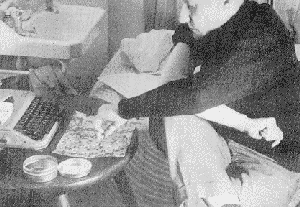
At this time he was totally dependent on heroin.
Like many addicts he tried kicking the habit himself. He would have a Spanish friend, known only as Kiki, hide his clothes so he couldn't go out and look for drugs.

With Kiki, one of the local boy lovers
of Burroughs' early Tanger years.
William Burroughs - The Doorway...
Burroughs later said that shooting Vollmer was a pivotal event in his life, and one which instigated his writing: "I am forced to the appalling conclusion that I would have never become a writer but for Joan's death...I live with the constant threat of possession, for control. So the death of Joan brought me in contact with the invader , the Ugly Spirit, and manoeuvred me into a life long struggle, in which I have had no choice except to write my way out."
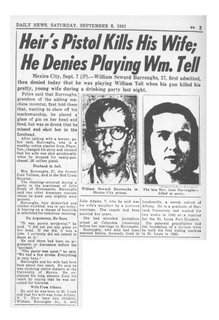
Tearsheet from New York Daily News of September 8, 1951.
William Burroughs - The importance of Joan Vollmer
He marries Joan.
When his wife Joan became pregnant with their son Billy in 1947,
Burroughs developed a seemingly failsafe idea how to support his growing family. So he had an idea: to rented a farm in Texas, grown marihuana there, and sell the crop on the New York drug market.
He did rent a farm, grew the crop, but did not dry it the proper way, and thus was unable to sell it in New York.
So he moved from Texas to New Orleans with his family. There he was detained for posession of dangerous drugs, and fled the country to Mexico City. Here Burroughs and his wife became heavily addicted to all the drugs available.
But the worse was about to happen.
In 1951, Burroughs shot and killed Joan in a drunken game of 'William Tell'.
He spent 13 days in jail before the killing was ruled "criminal imprudence", and was released on bail.
He was never the same ever since.
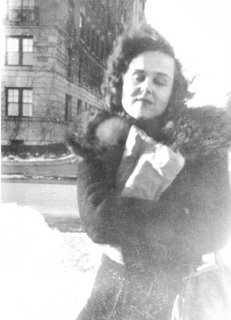
Joan Vollmer in 1946, at the time of her marriage
with Burroughs.
William Burroughs - The Gathering
He came back to the States and had many part time jobs. The one that the only one he seemed to like was being a bug exterminator in Chicago.
He hunged a lot of the time with David Kammerer and Lucien Carr but in 1944, Burroughs began living with Joan Vollmer Adams in an apartment they shared with Jack Kerouac and Edie Parker, Kerouac's first wife.
It is at this time that the initial group of friends, William Burroughs, Allan Gynsberg and Jack Kerouac started to socialize the most.
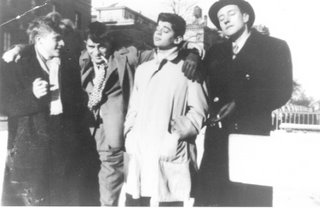
Riverside Drive. New York 1944.
From Left: Hal Chase, Jack Kerouac, Allen Ginsberg & Burroughs
William Burroughs -College years
In 1932, left home for an arts degree at Harvard University. He graduates 4 years after.
After leaving Harvard, Burroughs' formal education ended, except for brief attempts as a graduate student of anthropology at Harvard and as a medical student in Vienna.
While he was in Austria he met Ilse Klapper, a Jewish woman fleeing the country's Nazi government.
The two were never romantically involved, but Burroughs married her, against the wishes of his parents, in Croatia to allow her to gain a United States visa.

Burroughs at Harvard university, 1935.
William Burroughs
William Burroughs was one of the founders of the first counter culture movement, “The Beat Generation”.
The “Flower Power” in the 60´s was a derivation of the “Beat Generation”.
Some people say that William Burroughs was the greatest writer that ever lived. After all, here was a man who was one of the founders of "The Beat Generation"(together with Jack Kerouac and Allen Ginsberg), a man whose novel "Naked Lunch" helped break literature out of its traditional forms and removed the final barriers of censorship in America.
His life is so rich and full of such surreal events that it is possible to study it from a variety on levels.
For this reaserch ill focus on William Burroughs on the personal level as well as being part of a collective (The Beat Generation).

Project 3 - an experimental candy!
It was with lot of joy that i got the new brief, especially because of its characteristics.
It is very good to have a brief that is all about research, because for me GOOD DESIGN is proportional to its CONTENT.
I was even happier when I got William Burroughs!
I already got to know Jack Kerouac and had the opportunity to read some of his books, such as “On the road” and “The Dharma Bums”. I have known the Beat Generation since then, as well as some of the impacts that has had in our society.
Therefore, when I got “the father of the beat generation” as my topic of research I was in jubilation.
Now I have the opportunity to go deeper and to get to know why, how and what did Burroughs’s 84 years of existence changed in this world.
Strategies for my research?
Well since i allready now a bit about the beat genaration i wont be totally in the dark.
I know exactly where to look.
First thing, i´ll watch Cronenbergs movie version of Burroughs´s most famous novel the Naked Lunch,something i wanted to do for a while.
Basically ill try to live William Burroughs as close as i can get ( dont worry tutors i wont do heroin!) in order as depper as possible, like i said before: "to know why, how and what did Burroughs’s 84 years of existence changed in this world."
I´m looking foward to it.

Esta obra está licenciada sob uma Licença Creative Commons.

